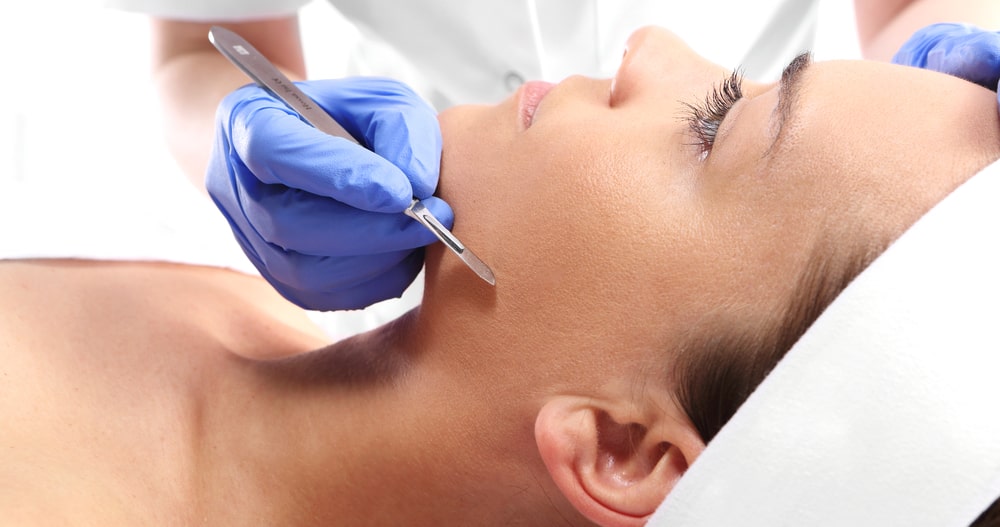
The skin on the face changes in appearance as a person ages. Brown spots can start to appear on the face and the skin can begin to look dull as well as show wrinkles, fine lines and even acne scars. Patients that want to gain a smooth and rejuvenated look to the facial skin often turn to dermaplaning to make changes in the look of their skin. Interested in learning how dermaplaning can make the desired changes to the appearance of the facial skin? Take a look at the information in this article to learn more about this hot facial skin rejuvenation trend.
Dermaplaning is a cosmetic procedure that is performed to remove the top layers of the skin of a patient. The procedure is performed in order to give the surface of the skin a smooth look. An exfoliating blade is used to remove dead skin cells. It is an ideal option for many skin types as well as people with damaged skin from sun exposure, fine wrinkles and acne scars.
The treatment starts with a cleaning of the face using a pH balanced cleanser that is gentle and the application of 10\\% povidone-iodine to help prevent infections on the skin. The exfoliating blade is aimed at a 45-degree angle and then moved across the skin at a slow speed. The blade works to remove any dead skin cells along with any scar tissue, debris or irritants that gather on the skin on a daily basis. The uneven look of the skin is eliminated so the skin will enjoy a smooth appearance.
It takes about 40-50 minutes to perform the treatment because the blade is moved across the skin at a slow speed. Once the treatment is completed, the doctor will make sure to soothe the skin with a moisturizer or sunscreen.
There is no real downtime after undergoing a dermaplaning treatment. There might be some redness for a few days but this will resolve on its own. The skin should start to have a more rejuvenated look immediately after the treatment but it can take up to three months for the final results to appear. The results are not permanent so patients will need to have a follow-up treatment in order to maintain the results.
The chances of an infection or scarring after dermaplaning is small but it can happen. Patients that develop a scar after dermaplaning can have it treated with a steroid injection that can soften the scar tissue.
Patients will need to be careful when it comes to their exposure to the sun after the procedure. Sun damage to the skin can create blotchy pigments and even reverse the positive results created by dermaplaning. Patients will also need to make sure and wear sunscreen on their face when they leave their home.
Patients that are interested in having dermaplaning are advised to schedule a consultation appointment with a board-certified doctor that is experienced in performing the treatment. The doctor will examine the current condition of the skin, as well as the medical history of the patient, in order to determine the type of results that the patient can expect to see.
The doctor will also need to take the skin type and skin coloring of the patient into account when planning the dermaplaning treatment.
Some patients want to save the money they would spend with the doctor and perform dermaplaning at home. They should know that this option will likely not yield the same results gained at the office of a doctor. In addition, the risks of an infection and a greater amount of pain during the treatment are increased when a person does the procedure at home.
Plus, a dermatologist is trained in the proper use of the scalpel as well as the performance of the procedure. A person trying it on their own at home does not have the proper training and skills to remove the desired amount of dead or dull skin.
When performed by a board-certified professional, dermaplaning can result in skin that is smoother and brighter. The skin that is removed is replaced by new and more youthful skin.
In addition, the removal of dead skin can also provide for a better penetration of skin creams and other skincare treatments that are part of the daily routine of a person. Makeup can also be applied more easily as the makeup will now be placed closer to the skin after the treatment.
The doctor will need to examine the current condition of the skin since skin that has severe acne, skin cancer or eczema might not be ideal for the treatment. Instead, the doctor might suggest that the patient try another treatment such as a chemical peel.
Once the dermatologist examines the skin of the patient and determines that the person is an ideal patient, a dermaplaning treatment plan can be made to provide the desired amount of skin rejuvenation.
MA